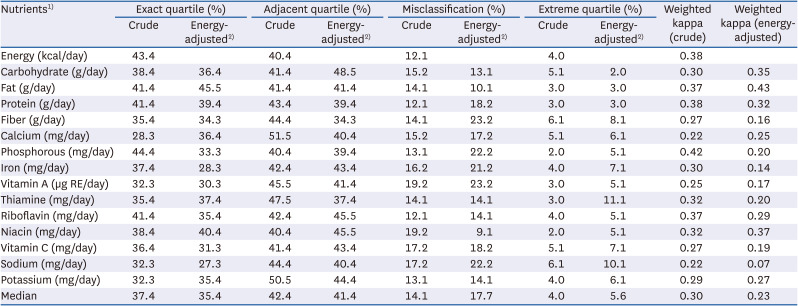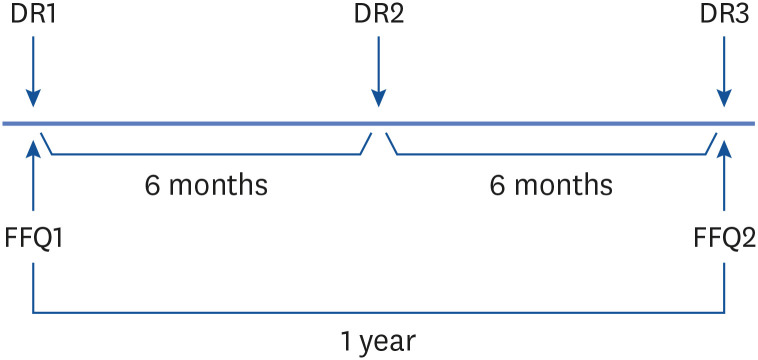1. Bray F, Ferlay J, Soerjomataram I, Siegel RL, Torre LA, Jemal A. Global cancer statistics 2018: GLOBOCAN estimates of incidence and mortality worldwide for 36 cancers in 185 countries. CA Cancer J Clin. 2018; 68:394–424. PMID:
30207593.

2. Jung KW, Won YJ, Kong HJ, Lee ES. Community of Population-Based Regional Cancer Registries. Cancer statistics in Korea: incidence, mortality, survival, and prevalence in 2015. Cancer Res Treat. 2018; 50:303–316. PMID:
29566481.

3. World Cancer Research Fund International. Diet, Nutrition, Physical Activity and Cancer: a Global Perspective - The Third Expert Report [Internet]. London: World Cancer Research Fund International;2018. cited 2020 October 10. Available from:
https://www.wcrf.org/dietandcancer.
4. Michels KB, Mohllajee AP, Roset-Bahmanyar E, Beehler GP, Moysich KB. Diet and breast cancer: a review of the prospective observational studies. Cancer. 2007; 109(Suppl):2712–2749. PMID:
17503428.
5. Rossi RE, Pericleous M, Mandair D, Whyand T, Caplin ME. The role of dietary factors in prevention and progression of breast cancer. Anticancer Res. 2014; 34:6861–6875. PMID:
25503112.
6. Rock CL, Demark-Wahnefried W. Nutrition and survival after the diagnosis of breast cancer: a review of the evidence. J Clin Oncol. 2002; 20:3302–3316. PMID:
12149305.

7. Miller AB. Role of nutrition in the etiology of breast cancer. Cancer. 1977; 39(Suppl):2704–2708. PMID:
872065.

8. Graham S, Zielezny M, Marshall J, Priore R, Freudenheim J, Brasure J, Haughey B, Nasca P, Zdeb M. Diet in the epidemiology of postmenopausal breast cancer in the New York State Cohort. Am J Epidemiol. 1992; 136:1327–1337. PMID:
1336931.

9. Subar AF, Thompson FE, Smith AF, Jobe JB, Ziegler RG, Potischman N, Schatzkin A, Hartman A, Swanson C, Kruse L, et al. Improving food frequency questionnaires: a qualitative approach using cognitive interviewing. J Am Diet Assoc. 1995; 95:781–788. PMID:
7797809.
10. Willett W. Chapter 5. Food frequency methods. Willett W, editor. Nutritional Epidemiology. New York (NY): Oxford University Press;2013. p. 70–95.
11. Shin WK, Song S, Hwang E, Moon HG, Noh DY, Lee JE. Development of a FFQ for breast cancer survivors in Korea. Br J Nutr. 2016; 116:1–6.

12. The Korean Nutrition Society. CAN-Pro 4.0 (Computer Aided Nutritional analysis program). Seoul: The Korean Nutrition Society;2011.
13. Ministry of Food and Drug Safety. Food Composition Database [Internet]. Cheongju: Ministry of Food and Drug Safety;2020. cited 2020 October 10. Available from:
https://www.foodsafetykorea.go.kr/fcdb/.
15. Willett W. Chapter 11. Implications of total energy intake for epidemiologic analyses. Willett W, editor. Nutritional Epidemiology. New York (NY): Oxford University Press;2013. p. 260–286.
16. Willett W. Chapter 12. Correction for the effects of measurement error. Willett W, editor. Nutritional Epidemiology. New York (NY): Oxford University Press;2013. p. 287–304.
17. Shu XO, Yang G, Jin F, Liu D, Kushi L, Wen W, Gao YT, Zheng W. Validity and reproducibility of the food frequency questionnaire used in the Shanghai Women’s Health Study. Eur J Clin Nutr. 2004; 58:17–23. PMID:
14679362.

18. Ahn Y, Kwon E, Shim JE, Park MK, Joo Y, Kimm K, Park C, Kim DH. Validation and reproducibility of food frequency questionnaire for Korean genome epidemiologic study. Eur J Clin Nutr. 2007; 61:1435–1441. PMID:
17299477.

19. Bland JM, Altman DG. Statistical methods for assessing agreement between two methods of clinical measurement. Lancet. 1986; 1:307–310. PMID:
2868172.

20. Willett WC, Sampson L, Stampfer MJ, Rosner B, Bain C, Witschi J, Hennekens CH, Speizer FE. Reproducibility and validity of a semiquantitative food frequency questionnaire. Am J Epidemiol. 1985; 122:51–65. PMID:
4014201.

21. Amanatidis S, Mackerras D, Simpson JM. Comparison of two frequency questionnaires for quantifying fruit and vegetable intake. Public Health Nutr. 2001; 4:233–239. PMID:
11299096.

22. Na YJ, Lee SH. Development and validation of a quantitative food frequency questionnaire to assess nutritional status in Korean adults. Nutr Res Pract. 2012; 6:444–450. PMID:
23198024.

23. Park MK, Noh HY, Song NY, Paik HY, Park S, Joung H, Song WO, Kim J. Validity and reliability of a dish-based, semi-quantitative food frequency questionnaire for Korean diet and cancer research. Asian Pac J Cancer Prev. 2012; 13:545–552. PMID:
22524822.

24. Kim DW, Song S, Lee JE, Oh K, Shim J, Kweon S, Paik HY, Joung H. Reproducibility and validity of an FFQ developed for the Korea National Health and Nutrition Examination Survey (KNHANES). Public Health Nutr. 2015; 18:1369–1377. PMID:
25167205.

25. Kim S, Lee JS, Hong KH, Yeom HS, Nam YS, Kim JY, Park YK. Development and relative validity of semi-quantitative food frequency questionnaire for Korean adults. J Nutr Health. 2018; 51:103–119.

26. Cade J, Thompson R, Burley V, Warm D. Development, validation and utilisation of food-frequency questionnaires - a review. Public Health Nutr. 2002; 5:567–587. PMID:
12186666.

27. Cade JE, Burley VJ, Warm DL, Thompson RL, Margetts BM. Food-frequency questionnaires: a review of their design, validation and utilisation. Nutr Res Rev. 2004; 17:5–22. PMID:
19079912.

28. Voss S, Kroke A, Klipstein-Grobusch K, Boeing H. Is macronutrient composition of dietary intake data affected by underreporting? Results from the EPIC-Potsdam Study. European Prospective Investigation into Cancer and Nutrition. Eur J Clin Nutr. 1998; 52:119–126. PMID:
9505157.

29. Nagel G, Zoller D, Ruf T, Rohrmann S, Linseisen J. Long-term reproducibility of a food-frequency questionnaire and dietary changes in the European Prospective Investigation into Cancer and Nutrition (EPIC)-Heidelberg cohort. Br J Nutr. 2007; 98:194–200. PMID:
17367573.

30. Kristal AR, Feng Z, Coates RJ, Oberman A, George V. Associations of race/ethnicity, education, and dietary intervention with the validity and reliability of a food frequency questionnaire: the Women’s Health Trial Feasibility Study in Minority Populations. Am J Epidemiol. 1997; 146:856–869. PMID:
9384206.

31. Beaton GH. Approaches to analysis of dietary data: relationship between planned analyses and choice of methodology. Am J Clin Nutr. 1994; 59(Suppl):253S–61S. PMID:
8279436.

32. Freedman LS, Schatzkin A, Midthune D, Kipnis V. Dealing with dietary measurement error in nutritional cohort studies. J Natl Cancer Inst. 2011; 103:1086–1092. PMID:
21653922.










 PDF
PDF Citation
Citation Print
Print





 XML Download
XML Download